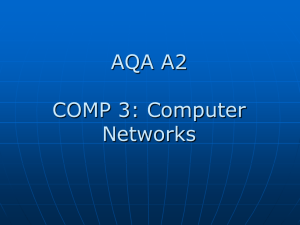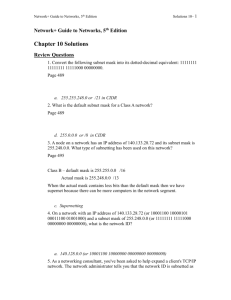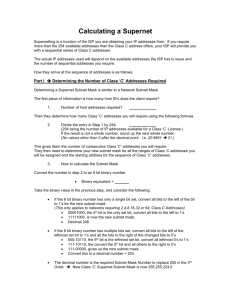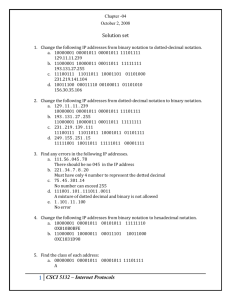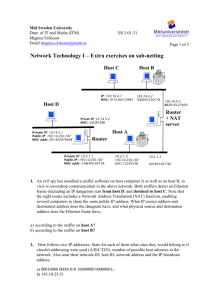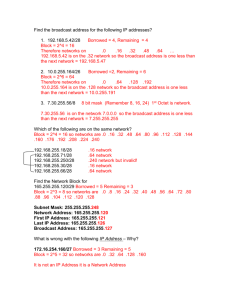File
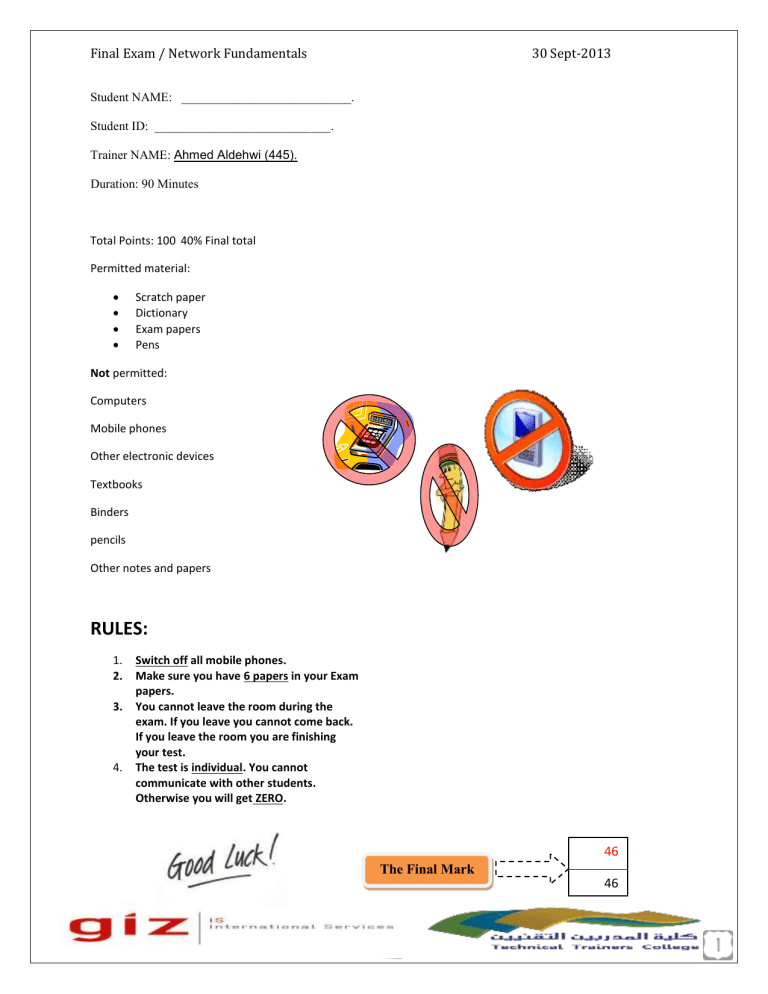
Final Exam / Network Fundamentals
Student NAME: ___________________________.
Student ID: ____________________________.
Trainer NAME: Ahmed Aldehwi (445).
Duration: 90 Minutes
Total Points: 100 40% Final total
Permitted material:
Scratch paper
Dictionary
Exam papers
Pens
Not permitted:
Computers
Mobile phones
Other electronic devices
Textbooks
Binders pencils
Other notes and papers
RULES:
1.
Switch off all mobile phones.
2.
Make sure you have 6 papers in your Exam papers.
3.
You cannot leave the room during the exam. If you leave you cannot come back.
If you leave the room you are finishing your test.
4.
The test is individual. You cannot communicate with other students.
Otherwise you will get ZERO.
The Final Mark
30 Sept-2013
46
46
The Final Exam / Network Fundamentals
Q1: Fill gaps by writing the correct answer: i.
There are 3 common topologies - Star, Ring, and..
bus ... ii.
Routers mostly work at layer ...
three (3) .. iii.
Switches work at layer...
two (2) .. iv.
TCP/IP is a protocol. It is short for..
Transmission Control Protocol/Internet Protocol ... v.
UDP is..
User Datagram Protocol .
.. and UDP works in … Transport (the Fourth) …layer.
Sept -2013
3
3
Q2: put ( √ ) in the front of the right statement OR ( x ) if it not correct :-
3
3
SMB is an Application layer protocol, it will provide for peer-to-peer file sharing in a workgroup ( √ )
This command (arp –a) can be used to troubleshoot domain name resolution issues. ( x )
transport layer manages data segments in OSI module. ( √ )
1000 BASE-TX and1000 BASE-SX are two types of media can provide bandwidth up to 1 Gb/s. ( √ )
DHCP protocol allows administrators to log into a server from remote locations and control a server as though logged in locally. ( x )
2046is the number of host addresses may be assigned when using the 128.107.0.0 network address with a subnet mask of 255.255.248.0 ( √ )
Q3:The OSI model consists of several layers. Write them down with the correct order (top-down):
NOTICE!
Each answer give you
½
OR take
½
of a question's markanda
½ for the right order.
4
4
1.
…
Application ..
layer
…………………………………………………………………..
2.
…
Presentation ..
.layer
…………………………………………………………………
3.
…
Session ..
layer
……………………………………………………………………….
4.
… Transport ..
layer ……………………………………………………………………..
5.
…
Network ..
layer
………………………………………………………………………
6.
… Data ..
link ..
layer ……………………………………………………………………...
7.
…
Physical ..
layer
……………………………………………………………………….
The Final Exam / Network Fundamentals Sept -2013
1
Q4: Think carefully. For the below image, which topology is it?
NOTICE!
This question give you one mark if its right.
1
…
Star topology
…
Q5: Choose the correct answer for the following questions, one or more could be the right answers:-
NOTICE!
Each option give you
½
OR take
½
of a question's mark.
14
14
I -From the picture above. What is a valid configuration IP, Subnet Mask and the Default Gateway: for
Host A? a.
IP address: 192.168.100.18; Subnet Mask: 255.255.255.0; Default Gateway: 10.1.1.5
b.
IP address: 192.168.100.20; Subnet Mask: 255.255.255.0; Default Gateway: 192.168.100.17
c.
IP address: 192.168.100.20; Subnet Mask: 255.255.255.245; Default Gateway: 192.168.10.17
d.
IP address: 192.168.100.20; Subnet Mask: 255.255.255.240; Default Gateway: 192.168.100.17
II -Which three commands will change the current configuration mode of a router? a) router rip b) line vty 0 4 c) enable secret class d) interface FastEthernet 0/1
The Final Exam / Network Fundamentals Sept -2013
III -From the picture above. When computer A sends a frame to computer D, what computers receive the frame? a.
only computer D. b.
Both computer A and D. c.
Computer A and computer D. d.
All devices receive the frame.
IV -A routing issue has occurred in you internetwork. Which of the following type of devices should be examined to isolate this error?
a) Router. b) Switch. c) Hub. d) Bridge.
V -From the picture above. Host A is transmitting data to host B. What addresses will host A use to for the destination IP and MAC addresses in this communication? a.
Destination MAC: AAAA:AAAA:AAAA Destination IP: 172.22.0.37 b.
Destination MAC: EEEE:EEEE:EEEE Destination IP: 172.22.0.75 c.
Destination MAC: EEEE:EEEE:EEEE Destination IP: 172.22.0.37 d.
Destination MAC: AAAA:AAAA:AAAA Destination IP: 172.22.0.37 & Destination MAC:
EEEE:EEEE:EEEE Destination IP: 172.22.0.75
VI -Which three addresses belong to the category of public IP addresses? a) 127.0.0.1
b) 196.1.105.6
c) 132.11.9.99
d) 172.16.9.10
The Final Exam / Network Fundamentals Sept -2013
VII -A network technician has made a UTP cable that is terminated as T568A on one end and T568B on the opposite end. What type of cable has been constructed? a) Patch . b) Console . c) Crossover . d) Straight-through .
Q6: Answer the following questions :-
8
8
1In this network we have a big problem.
What is the problem and what is the solution for this situation?
The problem is the collision that happens between the Hub and PC-D. To solve this problem we use CSMA/CD mechanism. Carrier Sense Multiple Access with Collision
Detection , whenever any PC wants to send a data, it first sends out a dummy electrical signal into the channel to check whether any incoming data traffic is coming down or the line is free. If the traffic is already coming down, then the dummy signal collides with the incoming traffic and sends back a jam signal to the PC so that, the PC is notified to hold its traffic for a random amount of time before attempting to send the data again. This process will continue until the line/channel becomes free. If the segment is free; the PC immediately initiates/send its data to the intended destination. This is how the data collision is avoided in half-duplex channels.
2What is a protocol?
aprotocol is a set of rules that enable two devices to connect and transmit data to one another. Protocols determine how data are transmittedbetween computing devices and over networks. They define issues such as error control and data compression methods.
3
3
The Final Exam / Network Fundamentals Sept -2013
Q 7 : For the IP address: 192.168.100.
0 /27, please answer the following questions in detailed ( with
Explaining):-
10
10
1.
What is the subnet mask and How many Hosts I can get from this ip ?
2.
What is the Broadcast ip and the network ip (network ID) ?
A.1- The subnet mask for this ip is 255.255.255.224, becausethe prefix is 27 and the total number for any ip address in version4 is 32 bits distributed in 4 Octets.So 32-27=5and that means the last Octet has 8 bits only the last 5 numbers or bits is reserved for the Host part and represented by "0". The ip address in binary system will be like this 11111111.11111111.11111111.11100000 all of these 1s is reserved for a Network.
Sothe subnet mask will be 255.255.255.224
= 128+64+32
SO decimal numbers that upper in subnet mask. So 2 power the number of Zeros=5 and the result will be 32 –
2=30 Hosts, we subtraction 2 because one ip for the Network ID and the other one is for the Broadcast ip.
So the Final answer is 30 HostsI can have in this network.
A.2Broadcast ip is 192.168.100.31, because this is the last ip in this Network and the last ip for any network is reserved for Broadcasting.
Network ID is 16 192.168.100.0, because the first ip in any network is reserved for the Network.
